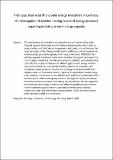Files in this item
Firm type, feed-in tariff, and wind energy investment in Germany : An investigation of decision making factors of energy producers regarding investing in wind energy capacity
Item metadata
| dc.contributor.author | Werner, Lone | |
| dc.contributor.author | Scholtens, Lambertus Johannes Regnerus | |
| dc.date.accessioned | 2018-06-10T23:37:54Z | |
| dc.date.available | 2018-06-10T23:37:54Z | |
| dc.date.issued | 2017-04-19 | |
| dc.identifier | 248065152 | |
| dc.identifier | 0b3cde66-4214-4c42-ac0e-9c46225432b2 | |
| dc.identifier | 84978712148 | |
| dc.identifier.citation | Werner , L & Scholtens , L J R 2017 , ' Firm type, feed-in tariff, and wind energy investment in Germany : An investigation of decision making factors of energy producers regarding investing in wind energy capacity ' , Journal of Industrial Ecology , vol. 21 , no. 2 , pp. 402-411 . https://doi.org/10.1111/jiec.12443 | en |
| dc.identifier.issn | 1530-9290 | |
| dc.identifier.other | ORCID: /0000-0001-5774-5191/work/69835033 | |
| dc.identifier.uri | https://hdl.handle.net/10023/13870 | |
| dc.description.abstract | The development of renewable and sustainable energy is advanced by public financial support. Particularly so in the German Energiewende, which seeks to replace nuclear and fossil electricity generation with wind, sun, and biomass. We study the impact of the (changes in the) feed-in tariff policy on the investment in wind electricity generation capacity in Germany in the period 2000-2014. We estimate a generic investment model which includes this support mechanism, the cost of capital, investment risks like wind and price volatility, and manufacturing costs. We discuss specific features for different types of wind energy investors, such as the incumbents, small private investors, diversified companies, and independent power producers. We find that a change in the feed-in tariff has a negative impact on investment capacity regarding the generation of wind energy: a one monetary unit increase in the variation of the tariff is to be associated with a decrease by 0.17 MW wind capacity installed. We argue it is policy uncertainty that makes investors shy away from making real investments. We also argue that the drivers for wind energy investment can differ along different types of firms. For the traditional power producers, especially electricity price volatility, construction costs, and carbon prices seem to matter. But for the other investor types, the feed-in tariff is crucial indeed. | |
| dc.format.extent | 10 | |
| dc.format.extent | 307760 | |
| dc.language.iso | eng | |
| dc.relation.ispartof | Journal of Industrial Ecology | en |
| dc.rights | Copyright © 2016, by Yale University. This work is made available online in accordance with the publisher’s policies. This is the author created, accepted version manuscript following peer review and may differ slightly from the final published version. The final published version of this work is available at https://doi.org/10.1111/jiec.12443 | en |
| dc.subject | Feed-in tariff | en |
| dc.subject | Firm type | en |
| dc.subject | Germany | en |
| dc.subject | Industrial ecology | en |
| dc.subject | Investment | en |
| dc.subject | Wind energy | en |
| dc.subject | HD Industries. Land use. Labor | en |
| dc.subject | HG Finance | en |
| dc.subject | NDAS | en |
| dc.subject | SDG 7 - Affordable and Clean Energy | en |
| dc.subject | SDG 15 - Life on Land | en |
| dc.subject.lcc | HD | en |
| dc.subject.lcc | HG | en |
| dc.title | Firm type, feed-in tariff, and wind energy investment in Germany : An investigation of decision making factors of energy producers regarding investing in wind energy capacity | en |
| dc.type | Journal article | en |
| dc.contributor.institution | University of St Andrews.School of Management | en |
| dc.contributor.institution | University of St Andrews.Centre for Responsible Banking and Finance | en |
| dc.identifier.doi | 10.1111/jiec.12443 | |
| dc.description.status | Peer reviewed | en |
| dc.date.embargoedUntil | 2018-06-10 |
This item appears in the following Collection(s)
Items in the St Andrews Research Repository are protected by copyright, with all rights reserved, unless otherwise indicated.

